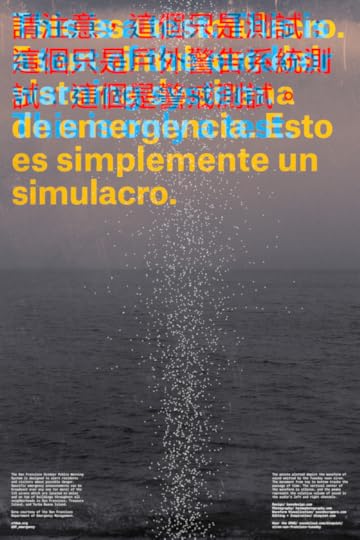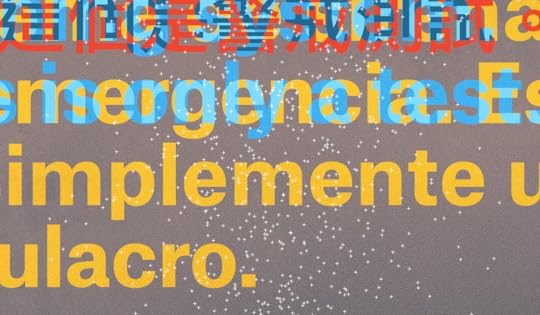Marc Weidenbaum's Blog, page 444
October 27, 2013
The Ambient Music of Lou Reed (RIP)
Lou Reed, cofounder, singer, and songwriter of the Velvet Underground, passed away today at the age of 71. He was a key figure in the pre-punk era of rock’n'roll, which stripped artifice in favor of rudimentary chord progressions and urban narrative. But because contradictions are at the heart of culture, Reed and his band also provided an important bridge between the worlds of rock’n'roll and contemporary art.
Much has been made of Reed having said, “One chord is fine. Two chords is pushing it. Three chords and you’re into jazz.” The comment is often referenced in favor of rock music that has an distinct disinterest in melodic, harmonic, and structural complexity. But one chord, at least in the metaphoric sense, also provided the foundation of some of Reed’s least rock-like recordings, music that aspired to an ambient state: his 1975 noise classic, Metal Machine Music, and his 2007 collection of contemplative soundscapes, Hudson River Wind Meditations.
The latter is a collection of meditative recordings — white noise in contrast with Metal Machine Music’s white heat — that he composed for his own tai chi practice:
The former is one of the most debated albums by a major rock musician. Many see it as a prank, an album of sonic violence that goes beyond merely challenging the ears of its audience. Such dismissal doesn’t explain why Reed returned to the music decades later, or how industrial rock, free improvisation, and noise music made good on the once isolated manifesto. That said, the perception of it as a prank assists in setting Metal Machine Music alongside John Cage’s 4’33″, another perennially reviled work: a wall of impenetrable sound to match Cage’s transparent silence:
October 24, 2013
Disquiet Junto Project 0095: Discuss Amongst

Each Thursday at the Disquiet Junto group on SoundCloud.com a new compositional challenge is set before the group’s members, who then have just over four days to upload a track in response to the assignment. Membership in the Junto is open: just join and participate.
This assignment was made in the afternoon, California time, on Thursday, October 24, with 11:59pm on the following Monday, October 28, 2013, as the deadline.
These are the instructions that went out to the group’s email list (at tinyletter.com/disquiet-junto):
Disquiet Junto Project 0095: Discuss Amongst
This week’s Disquiet Junto project is fairly open-ended. You don’t need to create a new track, necessarily. What you need to do is to post a single track, a relatively recent one, that you would like feedback on from your fellow music- and sound-makers in the Disquiet Junto.
There are three steps to this project, and each step is equally important:
Step 1: Upload a track. Please do not post a track that has previously appeared in the Disquiet Junto.
Step 2: When filling in the various informational fields, be sure to write in some length a description of your process in planning, composing, and recording it. This description is an essential element of the communicative process inherent in the Disquiet Junto.
Step 3: As tracks are added by other musicians, be sure to comment on at least two or three of them. The more people who participate, the stronger the feedback and conversation will be.
Deadline: Monday, October 28, 2013, at 11:59pm wherever you are.
Length: Your track should have a duration of between one and six minutes.
Title/Tag: Include the term “disquiet0095-discussamongst” in the title of your track, and as a tag for your track.
Download: Please consider employing a license that allows for attributed, commerce-free remixing (i.e., a Creative Commons license permitting non-commercial sharing with attribution).
Linking: When posting the track, be sure to include this information:
More on this 95th Disquiet Junto project, in which musicians post recent tracks with the express purpose of getting constructive feedback, at:
http://disquiet.com/2013/10/24/disqui...
More details on the Disquiet Junto at:
http://soundcloud.com/groups/disquiet...
October 23, 2013
Going Underground

Grand Central Station is for much of the day and night a place of contast motion, myriad motions, bodies and trains heading along countless trajectories. Up close it can feel like being at the center of a hurricane. From a distance, it can be a delirious blur. In the microphone of Sepulchra, aka Michael Raphael of Brooklyn, it is a rich white noise punctuated by footsteps and a monotone public address announcer.
Track originally posted at soundcloud.com/sepulchra. More from Sepulchra/Raphael at sepulchra.com.
October 21, 2013
Circle Round Berlin as if with Tilda Swinton

When the 2009 film The Invisible Frame was being made, Simon Fisher Turner did some field recordings of the production. The movie, by director Cynthia Beatt, follows Tilda Swinton as she bikes around Berlin — literally around Berlin, in that she is following the path that had once been the Berlin Wall. Writes Turner of his part of the project: “I shot the sound as they filmed and every evening I made a new piece from the day’s rushes. We went to many locations around the invisible wall and its remains. For about an hour I was allowed to wander unsupervised and recorded whatever I wanted. This recording is an edited version of the master.” The recording he mentions is his contribution to the great Touch Radio podcast. His is the 99th in the series. It’s about half an hour of industrial noise, aural signs of life where there had once been an armed silence (MP3).
Download audio file (Radio99.mp3)
Track originally posted at touchradio.org.uk. More on the film at invisible-frame.com. More from Turner at simonfisherturner.com.
This Poster Is a Test. It Is Only a Test.

Every Tuesday at noon in San Francisco, California, a siren rings out, after which a voice provides some modicum of comfort by explaining that the siren was a test, only a test. The siren is part of the city’s Outdoor Public Warning System. Brian Scott of Boon Design decided to treat the siren as a symbol for the city — that is, what R. Murray Schafer would have called a “soundmark,” or the sonic equivalent of a landmark — when he responded recently to a call for posters by AIGA SF, the local branch of the professional association for design. The poster project, titled AIGA InsideOutSF, explains itself as follows: “A curated exhibition and silent auction of original posters by some of the most influential San Francisco Bay Area and international creatives, revealing their personal impressions of San Francisco.”
Brian put together a small crew for his poster, which appears up top. The photography, with purposeful echoes of Hiroshi Sugimoto’s sublime horizons, is by Heimo Schmidt. Additional key reference points include Vija Celmins’ graphite drawings of waves and Michael Snow’s 1967 film Wavelength. The waveform, shown at a 90 degree angle from its usual horizontal mode, cascades down the center of the image. The waveform is portrayed as a series of crosses intended to connect the wave to the idea of a map — to align the waveform with 113 sirens distributed around San Francisco (see the map below). This waveform visualization was accomplished by Nick Sowers. As for my role, I weighed in with ideas, writing, and editing. The text on the poster shows the announcement in the three languages it is heard in: primarily English, but also Cantonese and Spanish. The layering is intended to get at the distortion inherent in many of the city’s speakers, and at the overlaying and echo effect of adjacent speakers.

And because the web image of the finished poster doesn’t do justice to the impact of Brian’s art, here is a detail:

More from Brian Scott and Boon Design at boondesign.com. More from Heimo Schmidt at heimophotography.com. More from Nick Sowers at soundscrapers.com.
Our siren poster, by the the way, isn’t the only sonic symbol of San Francisco to be drawn from in the AIGA project. Nor is it even the only one to emphasize a public address system. Below is the wonderful poster submitted to AIGA by Jeremy Matthews and Brett Wickens of the San Francisco–based Ammunition Group. It shows the bullhorn of famed local activist and politician Harvey Milk.

More on the AIGA InsideOutSF poster project at insideoutsf.org. The InsideOut SF Fall Gala, to be held on November 12, 2013, will raise funds for the AIGA (“towards scholarships, educational programming and community events” per the documentation) in an auction of the posters.
October 20, 2013
Dusk Guitar
“From a Height” is nearly four minutes of gentle, guitar-infused ambience, all just-before-dusk gleams breaking through thick hovering clouds. Layers of glistening chords and picked patterns shimmer in a slow swell of lush stasis. It is by Valiska, who notes in his brief accompanying note that the track is something from a compilation that never saw the light of day.
Track originally posted for free download at soundcloud.com/valiska. More from Valiska — that is, from Krzysztof Sujata of Calgary, Canada — at valiska.com.
October 19, 2013
The Central Nervous System in the Machine
The sound of the no-input mixer is not so much the ghost in the machine as it is the machine’s central nervous system. That’s part of what John Cage claimed to have heard in his famous encounter with an anechoic chamber: the sound that results when there is no other sound. Peter Kirn of createdigitalmusic.com has helpfully explained the “no-input mixer” approach as utilizing “controlled feedback rather than any other source of sound” and he has quoted Canadian composer Christian Carrière as called it “the sound of the circuits inside the mixer singing.” In the hands of Philadelphia–based Joo Won Park, the “no-input mixer” is less a matter of singing than full-on, tantrum-level glossolalia, a heavy gurgle of electric fissues. Up above is Park’s “October 1402 (for no-input mixer and computer),” which at times sounds like an arcade game on its last legs, and at others like freakazoid hardcore free jazz improvisation.
The track was originally posted for free download at soundcloud.com/joowon. More on Park at joowonpark.net.
October 17, 2013
Disquiet Junto Project 0094: Naturalist Trio

Each Thursday at the Disquiet Junto group on SoundCloud.com a new compositional challenge is set before the group’s members, who then have just over four days to upload a track in response to the assignment. Membership in the Junto is open: just join and participate.
This assignment was made in the afternoon, California time, on Thursday, October 17, with 11:59pm on the following Monday, October 21, 2013, as the deadline.
These are the instructions that went out to the group’s email list (at tinyletter.com/disquiet-junto):
Disquiet Junto Project 0094: Naturalist Trio
Combine the following three field recordings of animals into an unlikely vocal trio:
Bird:
http://www.freesound.org/people/kewel...
Kitten:
http://www.freesound.org/people/Kyste...
Pig:
http://www.freesound.org/people/confu...
You can manipulate the sounds as you see fit, but at some point in the finished piece each sound should be recognizable by its source material. You may not add external sound sources.
Deadline: Monday, October 21, 2013, at 11:59pm wherever you are.
Length: Your track should have a duration of between one and five minutes.
Information: Please when posting your track on SoundCloud, include a description of your process in planning, composing, and recording it. This description is an essential element of the communicative process inherent in the Disquiet Junto.
Title/Tag: Include the term “disquiet0094-naturalisttrio” in the title of your track, and as a tag for your track.
Download: Please consider employing a license that allows for attributed, commerce-free remixing (i.e., a Creative Commons license permitting non-commercial sharing with attribution).
Linking: When posting the track, be sure to include this information:
More on this 94th Disquiet Junto project, in which the sound of three animals is combined into an unlikely vocal trio, at:
http://disquiet.com/2013/10/17/disqui...
More details on the Disquiet Junto at:
http://soundcloud.com/groups/disquiet...
Photo via Flickr:
October 15, 2013
Win a 33 1/3 “Sampler Galley” Paperback (with Aphex Twin Chapter)
9781623568900 is the ISBN number of the book due out February 13, 2014, that I wrote about Aphex Twin’s 1994 album Selected Ambient Works Volume II for the 33 1/3 series. It also feels like the number of days since I posted regularly at Disquiet.com, but I am slowly digging myself out of post-book exhaustion and gearing up to get back at it. Also gearing up for next-book planning, a key part of which is factoring in a diminished exhaustion component. Here’s another number: the book with be the 90th in the 33 1/3 series.
Pictured above is a “sampler galley” of the next six books due out from 33 1/3. I have a spare copy, which will be given away as part of a contest in the next issue of the Disquiet.com email newsletter, which you can subscribe to at tinyletter.com/disquiet. Also included are segments of forthcoming books by Serge Gainsbourg, They Might Be Giants, Richard Hell and the Voidoids, Andrew W.K., and Gang of Four.
October 10, 2013
Disquiet Junto Project 0093: Netlabel Hybrid

Each Thursday at the Disquiet Junto group on SoundCloud.com a new compositional challenge is set before the group’s members, who then have just over four days to upload a track in response to the assignment. Membership in the Junto is open: just join and participate.
This assignment was made in the afternoon, California time, on Thursday, October 10, with 11:59pm on the following Monday, October 14, 2013, as the deadline.
These are the instructions that went out to the group’s email list (at tinyletter.com/disquiet-junto):
Disquiet Junto Project 0093: Netlabel Hybrid
This is a shared-sample project. Create a single new piece of music by employing the selected material of each the following three tracks. See below.
All three of these tracks were initially posted to the Internet with a Creative Commons license encouraging derivative reworking. This project — one in an ongoing series of netlabel remixes undertaken by the Disquiet Junto — is intended to address the unfortunate popularity of “ND” (i.e., “no derivatives”) licenses among netlabels.
Please only use the following material in your piece; you can transform in any way you choose, but do not introduce any new source material. The music originated on these three netlabels: Birdsong, Inoquo, and Qunabu.
1: Use the first 10 seconds of “Dark City” by Marc Pastco off the 12AX7 album, released by inoquo.com, based in Barcelona, Spain.
MP3: http://goo.gl/MXDTJv
2: Use the second 10 seconds (i.e., from :11 to :20) of “Zamenhof Blues” by Digital_Me (Shay Librowski) off the The Accordion E.P., released by birdsong.co.il, based in Israel.
MP3: http://goo.gl/ysydcH
3: Use the third 10 seconds (i.e., from :21 to :30) of “Archean” by PlotKA off the Circulation of Deposits EP, released by netlabel.qunabu.com, based in Gdańsk, Poland.
MP3: http://goo.gl/pM9AqI
Deadline: Monday, October 14, 2013, at 11:59pm wherever you are.
Length: Your track should have a duration of between one and five minutes.
Information: Please when posting your track on SoundCloud, include a description of your process in planning, composing, and recording it. This description is an essential element of the communicative process inherent in the Disquiet Junto.
Title/Tag: Include the term “disquiet0093-netlabelhybrid” in the title of your track, and as a tag for your track.
Download: Due to the nature of these releases, you must employ a license that allows for attributed, commerce-free remixing (i.e., a Creative Commons license permitting non-commercial sharing with attribution).
Linking: When posting the track, be sure to include this information:
More on this 93rd Disquiet Junto project, in which the music from three different netlabels was combined to create one track, at:
http://disquiet.com/2013/10/10/disqui...
More details on the Disquiet Junto at:
http://soundcloud.com/groups/disquiet...
This track is composed from material extracted from three pre-existing tracks: “Dark City” by Marc Pastco off the 12AX7 album, released by inoquo.com, based in Barcelona, Spain; “Zamenhof Blues” by Digital_Me (Shay Librowski) off the The Accordion E.P., released by birdsong.co.il, based in Israel; and “Archean” by PlotKA off the Circulation of Deposits EP, released by netlabel.qunabu.com, based in Gdańsk, Poland.
Image up top via:




